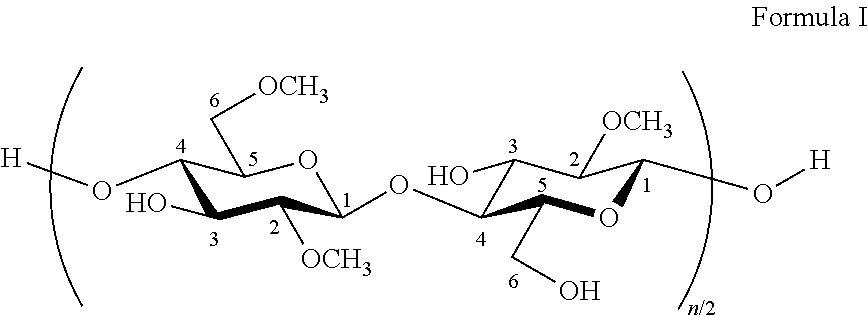Process for preparing an aqueous solution of a methylcellulose
a technology of methylcellulose and aqueous solution, which is applied in the field of preparing an aqueous solution of methylcellulose, can solve the problems of unduly long process, undue amount of cooling, and difficulty in fully hydrating, so as to reduce caloric intake and reduce stomach void volume
- Summary
- Abstract
- Description
- Claims
- Application Information
AI Technical Summary
Benefits of technology
Problems solved by technology
Method used
Image
Examples
example 1
[0089]An aqueous solution of the methylcellulose MC-I was prepared by adding a corresponding amount of the dry methylcellulose powder to water which had an initial temperature of 25° C. using a Yamato LT 400 lab overhead mixer having a rotor diameter of 63.5 mm and a gap distance between the outer diameter of the rotor and the stationary of 10.16 mm and running at 500 rpm, which resulted in a shear rate of 164 s−1, to achieve a good dispersion. The mixture of the methylcellulose MC-I and the water was cooled to 2° C. within 20 minutes while stirring at the same speed. After the mixture of methylcellulose MC-I and water reached the temperature of 2° C., the mixture was subjected to high shear using a Silverson L4-R high-shear mixer (rotor stator) running at 5000 rpm resulting in a shear rate of 56070 s−1 for 5 minutes. The Silverson L4-R high-shear mixer was equipped with a square hole high shear screen and had a rotor diameter of 38.1 mm and a gap of 0.178 mm.
[0090]The gel fracture ...
example 2
[0093]The procedure of Example 1 was repeated three times, except that the blend of methylcellulose MC-I and water was cooled to 0.5° C., 5° C. or 10° C. instead of cooling it to 2° C. The amount of methylcellulose MC-I was chosen to produce a 1.5% solution of MC-I, based on the total weight of the aqueous solution.
example 4
[0100]The procedure of Example 1 was repeated 6 times, except that the blend of methylcellulose MC-I and water was subjected to high shear using the same Silverson L4-R high-shear mixer as in Example 1, but the high-shear mixer was caused to run at a mixing speed as listed in Table 4. The chosen mixing speeds in the chosen device corresponded to the shear rates listed in Table 4. The blend of methylcellulose MC-I and water was cooled to 2° C. The amount of methylcellulose MC-I was chosen to produce a 1.5% solution of MC-I, based on the total weight of the aqueous solution.
TABLE 4Average Gel fracture force, NImmediately afterpreparation of theAfter 1 dayMixing speed, rpmShear rate, s−1aqueous solutionstorage at 4° C.1000112102.72.82000224303.83.63000336404.64.54000448606.56.65000560706.36.46000672806.46.3
PUM
| Property | Measurement | Unit |
|---|---|---|
| viscosity | aaaaa | aaaaa |
| temperature | aaaaa | aaaaa |
| temperature | aaaaa | aaaaa |
Abstract
Description
Claims
Application Information
 Login to View More
Login to View More - R&D
- Intellectual Property
- Life Sciences
- Materials
- Tech Scout
- Unparalleled Data Quality
- Higher Quality Content
- 60% Fewer Hallucinations
Browse by: Latest US Patents, China's latest patents, Technical Efficacy Thesaurus, Application Domain, Technology Topic, Popular Technical Reports.
© 2025 PatSnap. All rights reserved.Legal|Privacy policy|Modern Slavery Act Transparency Statement|Sitemap|About US| Contact US: help@patsnap.com

